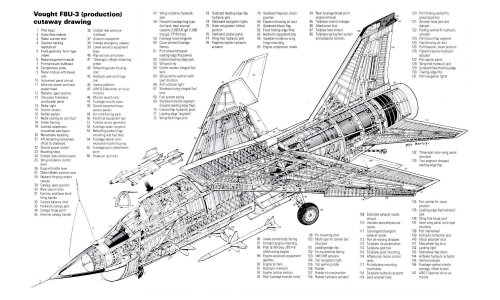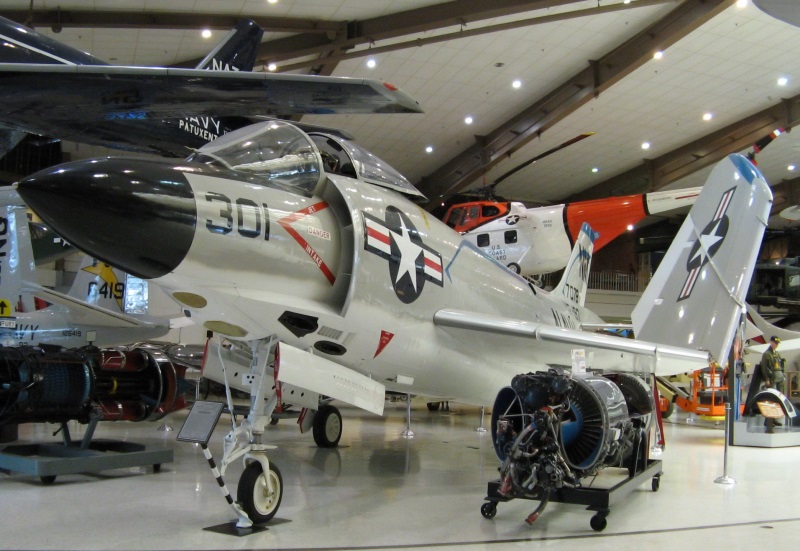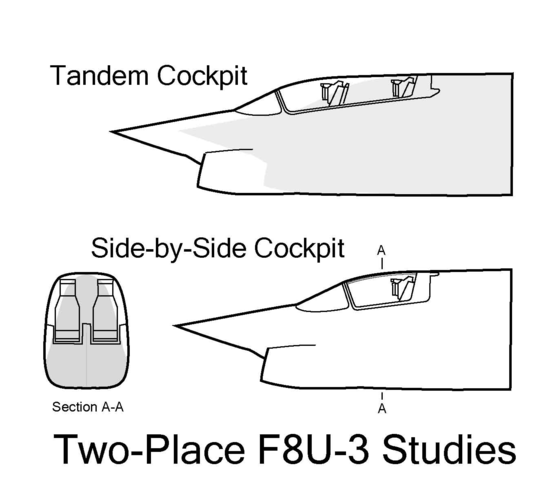apparition13
I really should change my personal text
- Joined
- 27 January 2017
- Messages
- 605
- Reaction score
- 1,107
I really like the F11F-2 Super Tiger and the F8U-3 Crusader III (especially the Advanced Crusader design with Eagle missile equivalents), but I wonder what the effects of both being adopted in the place of the F-8 and F-104 for the Super Tiger and the F-4 for the Crusader III would be. So I've decided to crowd source it here as a what if game.
Here's the scenario;
The F11F-2 Super Tiger (later F-11B) takes the place of the F-8 in USN service and the F-104 in NATO and Japan.
The F8u-3 takes the place of the F-4 in USN service.
Rolls Royce and Orenda find US partners for the RB106 and Iroquois. The RB106 goes into the F11F-2, the growth Iroquois with 33,000 lbs of thrust wet goes into the F8U-3.
Grumman addresses the USN's concern about the landing weight of the Super Tiger by increasing wing area to 300 sq. ft. (they had proposals to do this) reducing the landing speed, and thus the force of the landing.
This puts both aircraft in the neighborhood of 70lbs per square foot wing loading and thrust to weights at combat weight of just over 1, making Boyd happy.
Plot twist: when MacNamara says combine the F6D and F-111 programs the Navy says no thanks and cancels the missileer, but not the Eagle missile, since Vought has an Advanced Crusader variant of the F8U-3 designed that can carry a couple of Eagle missiles. USAF breathes a sigh of relief, and buys the Boeing design, which is late and over budget, but not nearly as much as the GD F-111 was, so all better there.
When Viet Nam rolls around the Navy fighters kick the crap out of the NV Migs. In desperation, the USAF is forced to buy both aircraft, the Crusder III for air superiority and the Super Tiger as a multi-role and F-100 replacement. At which point it also kicks the crap out of the NV Migs. It later develops both aircraft into USAF specific designs.
The end result is something like the F-15/F-16 hi-lo mix in both the USN and USAF a decade and a half earlier.
That's the set up. I'm not interested in how it's implausible, or why it wouldn't happen, I want to explore what would happen next if all of the above is true.
******
Both US aircraft are single engine. Would two engine designs proliferate as they did, or would single engine aircraft continue to be the preferred design for air superiority fighters? What might those look like?
Would a cheaper and earlier Boeing F-111 be more appealing to the UK? If so, does MRCA happen?
With the success of the US fighters in air combat, the impetus for the teen fighters is gone. Does this mean the F-15 program remains as a 60,000 pound class swing wing strike fighter (personally I like the Republic design)? Is that even necessary if the Boeing F-111 is a success?
The Super Tiger and Crusader III have dominated the Migs, how do the Soviets respond? Still with the Mig-23? Something more like the Su-27 and MiG-29? Still dual engine?
The teens were a quantum leap over Soviet designs, which led to the Su-27 and MiG-29 as their counter to the teens. In this scenario, the Soviets need to counter the Super Tiger and Crusader III. Which means that rather than the Soviets responding to the teens with their counter, the U.S. and its allies will be countering the Soviet response to the F11F-2 and F8U-3. What would a teen series developed in the late 70s and early 80s look like? What does this mean for the ATF and Stealth? Would pushing the ATF/NATF/MRF etc. designs back a few years help or hinder stealth? And would the ATF be single engine, with a 50,000+ class engine?
Do Top Gun and related programs develop if the U.S. is more successful in air combat than it was historically?
I'm assuming that without the F-4, a multi-role F8U-3 would be developed. But I also think more A-6s would wind up in USN service, and more F-111s in the USAF. When would a replacement for the A-6 happen, and what would it be like? Another pure attack aircraft, or a strike-fighter? Same for the F-111. Or do you think I'm wrong, in which case what do you think would fill the F-4 attack void?
Would the A-7 happen, or would F11-2s take on the role? Grumman was making them attack capable for the F-104 strike missions, and they could self-escort (and I suspect would replace the A-4 barring and A-4 Spey with much longer range), but the A-7 has more range and carrying capacity. Although a sufficiently powerful and compact turbofan engine might do the trick for the Super Tiger where range is concerned.
Does the A-10 still get put into service? I don't really see this scenario impacting the A-10, but maybe you do.
Without the teens, the Northrop P530 might look awfully appealing as a Super Tiger replacement. Would Northrop have a winner? How about the AJ-37? Or an RB106 Mirage, or one of the big two engine Mirages (ACF or 4000)? At least until the new teens come around in the 80s.
What haven't I mentioned? Impact on the Yom Kippur War? Total production numbers of the two aircraft compared to the F-4 and F-104? Impact on industry? Would McDonnell or Lockheed survive without their fighters? Could they move in a different direction? What happens to Douglas if McDonnell isn't there to merge with? What else? Respond to one of more of the questions, or to something I didn't list here. Basically, just take the scenario and run with it.
Here's the scenario;
The F11F-2 Super Tiger (later F-11B) takes the place of the F-8 in USN service and the F-104 in NATO and Japan.
The F8u-3 takes the place of the F-4 in USN service.
Rolls Royce and Orenda find US partners for the RB106 and Iroquois. The RB106 goes into the F11F-2, the growth Iroquois with 33,000 lbs of thrust wet goes into the F8U-3.
Grumman addresses the USN's concern about the landing weight of the Super Tiger by increasing wing area to 300 sq. ft. (they had proposals to do this) reducing the landing speed, and thus the force of the landing.
This puts both aircraft in the neighborhood of 70lbs per square foot wing loading and thrust to weights at combat weight of just over 1, making Boyd happy.
Plot twist: when MacNamara says combine the F6D and F-111 programs the Navy says no thanks and cancels the missileer, but not the Eagle missile, since Vought has an Advanced Crusader variant of the F8U-3 designed that can carry a couple of Eagle missiles. USAF breathes a sigh of relief, and buys the Boeing design, which is late and over budget, but not nearly as much as the GD F-111 was, so all better there.
When Viet Nam rolls around the Navy fighters kick the crap out of the NV Migs. In desperation, the USAF is forced to buy both aircraft, the Crusder III for air superiority and the Super Tiger as a multi-role and F-100 replacement. At which point it also kicks the crap out of the NV Migs. It later develops both aircraft into USAF specific designs.
The end result is something like the F-15/F-16 hi-lo mix in both the USN and USAF a decade and a half earlier.
That's the set up. I'm not interested in how it's implausible, or why it wouldn't happen, I want to explore what would happen next if all of the above is true.
******
Both US aircraft are single engine. Would two engine designs proliferate as they did, or would single engine aircraft continue to be the preferred design for air superiority fighters? What might those look like?
Would a cheaper and earlier Boeing F-111 be more appealing to the UK? If so, does MRCA happen?
With the success of the US fighters in air combat, the impetus for the teen fighters is gone. Does this mean the F-15 program remains as a 60,000 pound class swing wing strike fighter (personally I like the Republic design)? Is that even necessary if the Boeing F-111 is a success?
The Super Tiger and Crusader III have dominated the Migs, how do the Soviets respond? Still with the Mig-23? Something more like the Su-27 and MiG-29? Still dual engine?
The teens were a quantum leap over Soviet designs, which led to the Su-27 and MiG-29 as their counter to the teens. In this scenario, the Soviets need to counter the Super Tiger and Crusader III. Which means that rather than the Soviets responding to the teens with their counter, the U.S. and its allies will be countering the Soviet response to the F11F-2 and F8U-3. What would a teen series developed in the late 70s and early 80s look like? What does this mean for the ATF and Stealth? Would pushing the ATF/NATF/MRF etc. designs back a few years help or hinder stealth? And would the ATF be single engine, with a 50,000+ class engine?
Do Top Gun and related programs develop if the U.S. is more successful in air combat than it was historically?
I'm assuming that without the F-4, a multi-role F8U-3 would be developed. But I also think more A-6s would wind up in USN service, and more F-111s in the USAF. When would a replacement for the A-6 happen, and what would it be like? Another pure attack aircraft, or a strike-fighter? Same for the F-111. Or do you think I'm wrong, in which case what do you think would fill the F-4 attack void?
Would the A-7 happen, or would F11-2s take on the role? Grumman was making them attack capable for the F-104 strike missions, and they could self-escort (and I suspect would replace the A-4 barring and A-4 Spey with much longer range), but the A-7 has more range and carrying capacity. Although a sufficiently powerful and compact turbofan engine might do the trick for the Super Tiger where range is concerned.
Does the A-10 still get put into service? I don't really see this scenario impacting the A-10, but maybe you do.
Without the teens, the Northrop P530 might look awfully appealing as a Super Tiger replacement. Would Northrop have a winner? How about the AJ-37? Or an RB106 Mirage, or one of the big two engine Mirages (ACF or 4000)? At least until the new teens come around in the 80s.
What haven't I mentioned? Impact on the Yom Kippur War? Total production numbers of the two aircraft compared to the F-4 and F-104? Impact on industry? Would McDonnell or Lockheed survive without their fighters? Could they move in a different direction? What happens to Douglas if McDonnell isn't there to merge with? What else? Respond to one of more of the questions, or to something I didn't list here. Basically, just take the scenario and run with it.




